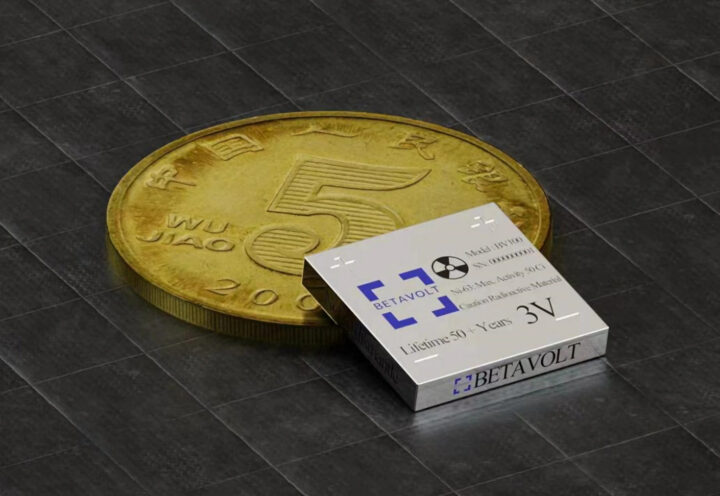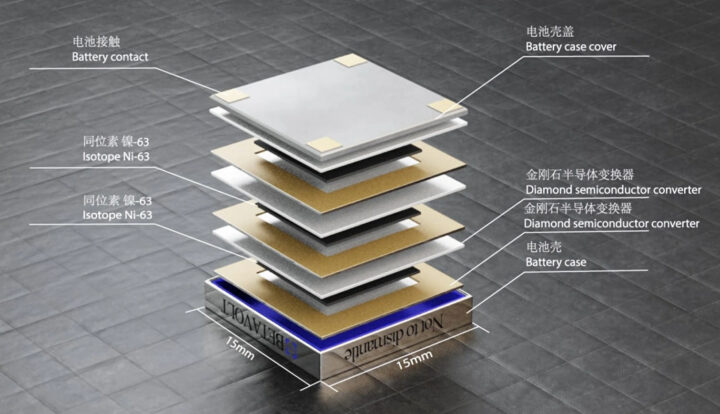Btavolt BV100 is a nuclear battery that never needs to be charged and designed to output 3V/100µW (microwatts) for over 50 years for the aerospace industry, AI equipment, medical devices, MEMS systems, advanced sensors, small drones, and micro-robots.
At 15x15x5mm, the 50-year nuclear battery is fairly small although 100 microwatts is not a lot of power… That’s only the first step, however, as the Chinese company plans to launch a 1W nuclear battery, and says that if (government) policies allow, nuclear batteries should eventually enable smartphones that never need to be charged and forever fly drones…
How does that all work? First, as Betavolt states in its press release (in Chinese), it’s not exactly new technical as in the 1960’s, the US and the USSR used betavoltaic batteries for the space programs. But those were relatively large and heavy, operated at high temperatures, and were expensive. Wikipedia mentions that one of the first consumer applications for this type of battery was pacemakers, but they were eventually dislodged by cheaper Lithium batteries.
What’s new are the materials involved namely radioactive nickel-63 with a half-life of about 100 years that decays into non-radioactive copper to produce electricity and a “single-crystal diamond semiconductor” developed by Betavolt’s scientists. The basic structure of the solution is comprised of a 2-micron-thick nickel-63 sheet placed between two 10-micron-thick diamond semiconductor converters. The battery stacks several of those and also comes with a case, case cover, and contacts.
The Wikipedia article mentions an invention from 2018 that looks similar: :
In 2018 a Russian design based on 2-micron thick nickel-63 slabs sandwiched between 10 micron diamond layers was introduced. It produced a power output of about 1 μW at a power density of 10 μW/cm3. Its energy density was 3.3 kWh/kg.
So it might be a collaborative effort between Russia and China. Check out the research paper for details.
“Nuclear” immediately raises safety concerns but a document from the Environmental Health and Safety Department of Oregon State University reports that Nickel-63 only travels 5.5cm in the air and 60μ in water. They further add:
Note that 63Ni presents no external dose hazard to humans except to lenses of eyes, and the 63Ni contact would have to be on the surface of the eye to produce a dose.
The radioactive material in the BV100 nuclear battery is also stored in a case, so it looks pretty safe to me. Ingesting the battery could become an issue – for example for young children – but I suppose those are supposed to be soldered to a board (TBC).
More powerful nuclear batteries that would be used with smartphones or drones may not be based on Nickel-63 as the company also experiments with other isotopes such as strontium-90, promethium-147, and deuterium to develop betavoltaic batteries with higher power and shorter service life of 2 to 30 years.
Via Tom’s Hardware

Jean-Luc started CNX Software in 2010 as a part-time endeavor, before quitting his job as a software engineering manager, and starting to write daily news, and reviews full time later in 2011.
Support CNX Software! Donate via cryptocurrencies, become a Patron on Patreon, or purchase goods on Amazon or Aliexpress







That’s really nice. 100uW is a lot, it’s 33uA at 3V, it’s sufficient to maintain an RTC clock ticking for example. It can also be used to charge a capacitor that will deliver 47mA for one minute once a day, in weather probes for example. There are plenty of applications to this. It’s also cool to learn that 63Ni emits low-energy particles, because that’s indeed one of the points that tend to scare the population who doesn’t realize that sometimes they’re having such stuff in their food as a conservant!
It is highly unlikely these cells will reach consumer market due to the fact, half life of Nickel-63 is ~100 years. It takes 10 half life period (1000 years) for a nuclear entities to decay to a natural level to dispose.
> But those were relatively large and heavy, operated at high temperatures, and were expensive
Not exactly. Large and heavy was (and still is) more powerful thermo-electric ones: RTG or RITEG, used in Space or in remote lighthouses – for example built by USSR in Arctic Circle with mass from hundreds to thousands kg.
Later US and USSR created small ones: betavoltaic used in pacemakers. For example in 1975 USSR install one called РЭКС-А1 on Plutonium, but yes they are high cost and displaced by Lithium cells.
As far as I can understand the hard part is to create and enrich 63Ni itself, which done in different stages in centrifuge and in RBMK-1000 type reactors. Those tech slowly improved from 2007 to 2019.
P.S. The best news article I read so far regarding this battery.
“nuclear batteries should eventually enable smartphones that never need to be charged”
Ok, so, the hardest (power delivery) is done.
Now, let’s invent the smartphone who will run for 50 years 😉
https://en.wikipedia.org/wiki/Nokia_3310
You’re welcome.
He said SMARTphone. D’uh!
While those Nokias were unbelievably durable and lasted for days without a charge, they can’t do any of the tasks, you do with your today’s phone.
Eh, one could argue that actually makes them smarter than modern phones.
Russia nether invented nothing… Just look at the fake Kinjal and the fake speed annouced. So it’s look like a bad propaganda, and between us, 100uW is just ridiculous as a simple HiCap do better !
Chris you do realise that betavoltaic devices very similar to this that produce 100 uW have existed for over a decade and are produced by a US company. If there wasn’t a market for them then they wouldn’t exist. 100 uW continuously for 10 or 50 years is very good for some applications.
This would make it an awesome use for RTC, but not really enough for general purpose MCUs (mind you: I know MCUs are already not general purpose, but I’m referring to the kind like ESP32 and Arduino)